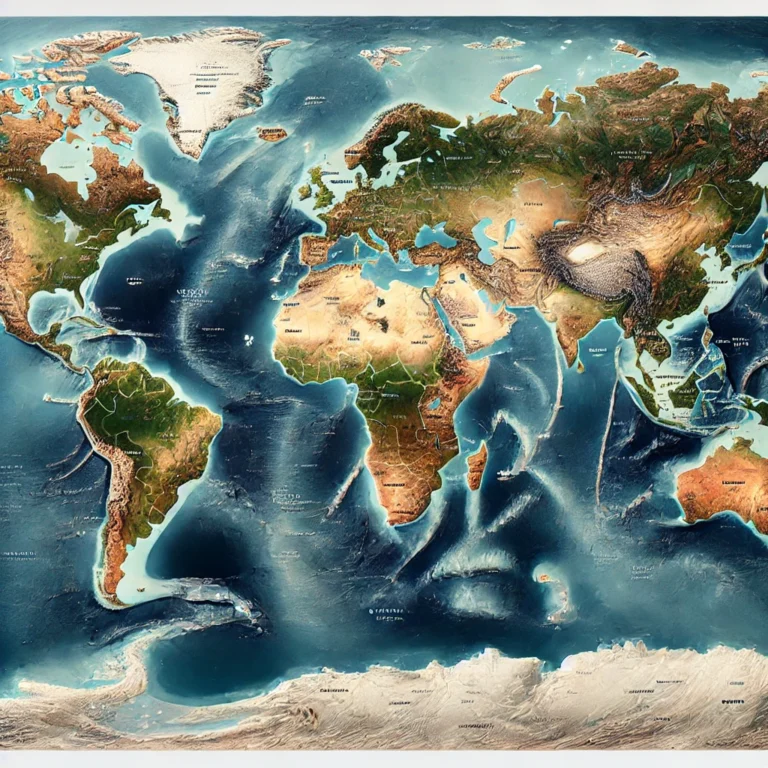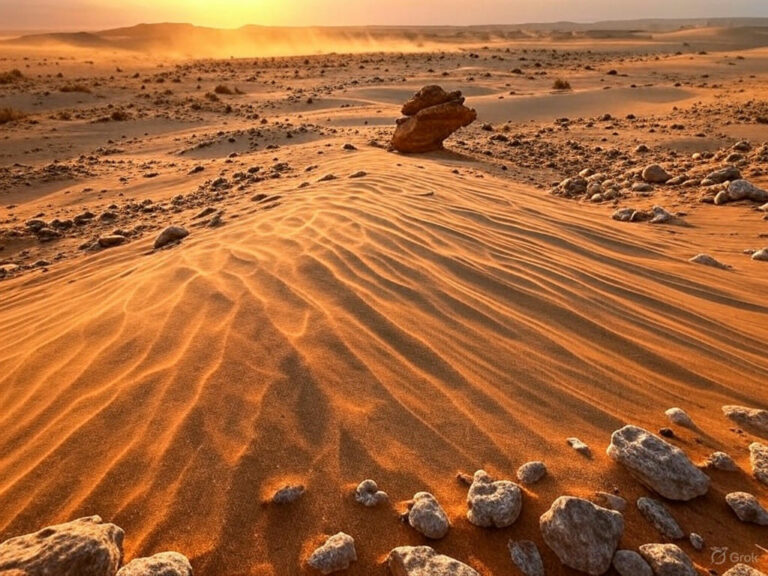Wind Eroded Arid Landforms
Let’s say you are standing in the middle of a vast desert, under the blazing sun. The air is hot, and strong winds are constantly brushing past you, carrying tiny sand particles. Over thousands of years, these sand particles have sculpted some of the most fascinating and dramatic landforms you can imagine. Today, we’ll take a fascinating journey through these wind-eroded arid landforms — natural masterpieces carved solely by the power of wind.
1. Mushroom Rocks (Pedestal Rocks)
💭 Visualize This:
Imagine walking in a desert and suddenly spotting a rock that looks exactly like a giant umbrella or a mushroom. Its upper part is broad and wide like the canopy of an umbrella, while its lower part is extremely narrow — like a pedestal holding the upper rock.
👉 This is what we call a Mushroom Rock or Pedestal Rock.
📖 How is it formed?
The key player here is wind abrasion. In deserts, strong winds carry fine sand particles that act like sandpaper. When the wind blows, it hits the rock continuously, but here’s the twist:
- Near the ground, the wind carries the maximum concentration of sand particles, causing intense erosion.
- Higher up, the wind carries fewer sand particles, resulting in less erosion.
So, the base of the rock gets eroded much faster than the upper part, ultimately forming a narrow base and a broad top, just like a mushroom or an umbrella.
✔ Why does it look like an umbrella?
Because the lower part (base) faces more abrasion due to the heavy sand load in the wind, while the upper part remains relatively unaffected. This differential erosion creates the mushroom-shaped rock.

2. Inselbergs
💭 Visualize This:
Now imagine you’ve traveled further into the desert, and you see a massive isolated hill rising sharply from a flat landscape — almost like a lone warrior standing in the middle of a battlefield. This lonely hill is called an Inselberg.
👉 The term Inselberg comes from the German language, where Insel means island and berg means mountain. So, an Inselberg is like an island of rock in the middle of a flat desert.
📖 How is it formed?
- Earlier, this area might have been covered by rocks and hills. Over millions of years, wind erosion and weathering wore down the softer rocks, leaving only the hard, resistant rocks standing.
- Eventually, the landscape became flat except for the stubborn hard rock that refused to erode.
- This left-over hill is called an Inselberg.
✔ Real-Life Example:
- Uluru Rock in Australia is one of the world’s most famous Inselbergs.
- Matopos Hill in Zimbabwe is another classic example.

3. Deflation Hollows
💭 Visualize This:
As you continue your desert journey, you suddenly notice large shallow depressions or basins on the ground — almost like someone scooped out a part of the land. This is called a Deflation Hollow.

📖 How is it formed?
- Imagine strong winds continuously blowing loose particles (sand, dust, small rocks) from a particular area.
- Over time, the surface material gets scooped out, creating a depression or hollow in the ground.
- This hollow is known as a Deflation Hollow.
👉 This process is called deflation, where wind removes loose material, resulting in shallow depressions.
Some of the world’s largest deflation hollows are found in the Sahara Desert, where strong winds continuously erode loose surface materials.
4. Yardangs
💭 Visualize This:
Now you walk further and find long, sharp, parallel ridges of rock running in the same direction as the wind. These ridges look like someone carefully carved them into neat rows. These are called Yardangs.

📖 How is it formed?
- Imagine the desert floor has both hard and soft rocks.
- When strong winds blow, they easily erode the softer rocks, but the harder rocks remain intact.
- Over time, sharp, linear ridges are formed, running parallel to the direction of the wind.
👉 This differential erosion creates sharp ridges (Yardangs) separated by deep grooves.
👉 They appear almost like knife-blades cutting through the desert.
✔ Fun Fact:
- Yardangs are common in the Sahara Desert, the Thar Desert (India), and parts of Iran.
- In ancient times, travelers often used Yardangs as natural navigation guides.
5. Zeugen
💭 Visualize This:
Now, as you explore further, you come across something that looks like a flat table of rock standing on a softer base. This is called a Zeugen.

📖 How is it formed?
- Imagine two layers of rock:
- Upper layer: Hard, resistant rock (like granite)
- Lower layer: Soft, easily erodible rock (like sandstone).
- The wind erodes the softer rock faster than the harder rock.
- Over time, the upper resistant rock stands as a table-like structure, supported by the softer rock beneath.
- This creates a flat-topped rock with steep sides, resembling a table.
👉 This is called a Zeugen.
✔ Fun Fact:
- Think of it as a “cake” with a tough upper crust and soft sponge beneath — the wind eats away the sponge but leaves the crust intact!
- Found in the deserts of Africa, the Middle East, and parts of Rajasthan.
6. Demoiselles
💭 Visualize This:
Finally, you stumble upon tall, thin rock pillars standing upright in the middle of the desert — almost like guardians protecting the land. These are called Demoiselles.

👉 Demoiselles is a French word meaning young ladies, referring to the graceful, tall appearance of these rock pillars.
📖 How is it formed?
- Once again, you have hard rock (on top) and soft rock (beneath).
- Wind continuously erodes the soft rock, but the hard rock resists erosion.
- Eventually, the soft rock erodes away completely, leaving behind tall, slender rock pillars (the hard rock).
- These pillars look like stone guardians standing alone in the desert.
👉 This is what we call Demoiselles.
💯 Quick Recap






